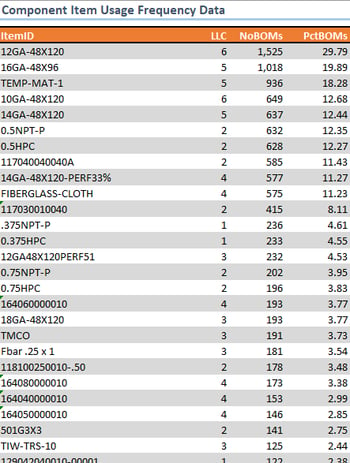In order to understand better how to manage your supply chain effectively, and how to maximize ROI on your investment in inventory in your supply chain, you really need to grasp some additional dimensions that help define how your inventory gets consumed across your supply chain.
In our discussions, we are going to use bills of material (BOMs) and a manufacturing environment. However, the same principle applies in consumption scenarios where items are consumed from your supply chain inventories by different customers, different distribution centers, or even if the BOMs reside outside the four walls of your supply chain operations at customer sites.
 The accompanying figure shows sample data displaying component items (from BOMs) and their usage.
The accompanying figure shows sample data displaying component items (from BOMs) and their usage.
- LLC (Low Level Code) indicates the lowest level in any BOM at which the component item is consumed.
- NoBOMs (number of BOMs) is the number of bills of materials in which the component item is found.
- PctBOMs (percent of BOMs) represents the percent of all bills of materials in which the component is used.
So, in our example, 12-gauge 4-foot by 10-foot sheets (ItemID = 12GA-48X120) of metal are consumed in nearly 30 percent of all manufacturing BOMs. Its neighbor in the list, 16GA-48X96, is consumed in just over 1,000 BOMs, representing about 20 percent of all standard BOMs in these operations.
Chances are the supply chain managers are already intuitively aware of just how critical these two components are to their operations. Being out of 12GA-48X120, theoretically, could halt production and delay delivery of more than 1,525 different items to customers.
What may too easily escape the attention of supply chain managers, however, are SKUs (ItemIDs) like .0375NPT-P. This item is consumed only in BOM level 1 (final assembly), but an out-of-stock on this item can halt the delivery of as many as 236 different products! At 4.6 percent, that means about one out of 20 products in their active BOM list is affected by the buffering of this SKU.
Similarly, Item ID 0.5NPT-P is consumed as a component at a low-level of 2 (pre-final assembly), but being out-of-stock on this item could halt production on more than 600 products (about one out of eight—12.35 percent of—products for this example operation).
Supply chain managers should be aware of these linkages, but many ERP and other manufacturing systems do not make these kinds of data readily accessible to managers and users. This is unfortunate.
Knowing BOM Low Level
Knowing a SKUs BOM low level (LLC) is also important in managing toward increasing ROI. All other factors being equal, it makes more sense to costs on items that are consumed in the production of 20 or 30 percent of your manufactured goods, than to spend time eking out small cost gains on items that may be consumed in smaller quantities an on only one or two percent of your finished goods.
However, there is another important factor to consider. It may prove far more cost-effective—and improve supply chain ROI dramatically—to buffer more of an item like 12GA48X120PERF51 that is consumed in 232 BOMs than to buffer larger quantities of some or all of the 232 SKUs in which it is a component. These calculations can be readily made, but it will depend upon the manufacturing lead-time required for the transformation of 12GA48X120PERF51 into its 232 various resulting produced items. Nevertheless, the calculation is straightforward. Contact me if you’d like to know how to do.
Think on these things. How are you making your discoveries about these dimensions in your supply chain? Leave your comments below, or feel free to contact us directly.




